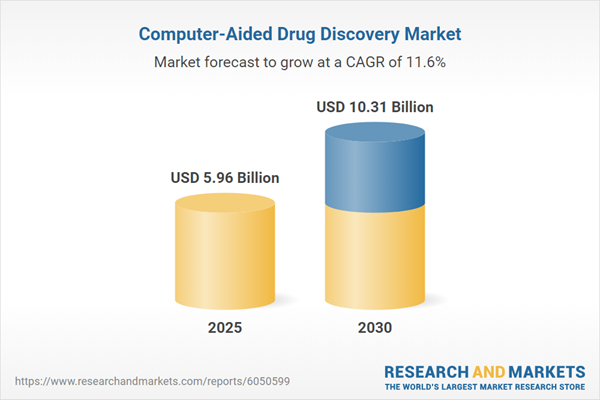The computer-aided drug discovery market is projected to grow at a CAGR of 11.59% over the forecast period, increasing from US$5.955 billion in 2025 to US$10.306 billion by 2030.
Drug discovery is a lengthy and complex process, but digital transformation is enhancing efficiency and effectiveness in the pharmaceutical industry. The integration of computer-aided drug discovery, automation, and digitization has become essential for improving quality, reducing costs, and shortening timelines. As resource constraints and changing scenarios arise, automation and digitization are key drivers of business growth. The application of quantum mechanics in computer-aided drug discovery has enabled highly accurate in-silico modeling of biological and chemical systems, facilitating the identification of novel drug candidates. The rising incidence of chronic diseases has intensified the need for rapid drug development, further boosting the growth of the computer-aided drug discovery market. According to the National Center for Health Statistics, it is projected that there will be 1,958,310 new cancer cases and 609,820 cancer deaths in the United States in 2023, underscoring the urgency of addressing these health challenges.
Drug discovery is a lengthy and complex process, but digital transformation is enhancing efficiency and effectiveness in the pharmaceutical industry. The integration of computer-aided drug discovery, automation, and digitization has become essential for improving quality, reducing costs, and shortening timelines. As resource constraints and changing scenarios arise, automation and digitization are key drivers of business growth. The application of quantum mechanics in computer-aided drug discovery has enabled highly accurate in-silico modeling of biological and chemical systems, facilitating the identification of novel drug candidates. The rising incidence of chronic diseases has intensified the need for rapid drug development, further boosting the growth of the computer-aided drug discovery market. According to the National Center for Health Statistics, it is projected that there will be 1,958,310 new cancer cases and 609,820 cancer deaths in the United States in 2023, underscoring the urgency of addressing these health challenges.
Drivers of the Computer-Aided Drug Discovery Market:
- Expanding Use of Artificial Intelligence in Drug Discovery: The complexity and time-consuming nature of new drug discovery necessitate advanced solutions. Identifying suitable compounds that can effectively bind to specific disease-related targets requires screening vast numbers of molecules. AI is transforming this process by enabling the discovery of potential compounds through technologies such as knowledge graphs, in-silico target identification, and target ranking, which expedite treatment development with greater precision.
Geographical Trends Shaping the Computer-Aided Drug Discovery Market:
- Significant Growth in North America: The computer-aided drug discovery market is poised for substantial growth in the United States due to several factors, including a rising prevalence of mental health disorders, advancements in AI technologies, and increasing acceptance of telehealth solutions. The demand for effective treatment options for mental health issues such as anxiety, depression, and PTSD has surged since the COVID-19 pandemic exacerbated these challenges.
Reasons for buying this report:
- Insightful Analysis: Gain detailed market insights covering major as well as emerging geographical regions, focusing on customer segments, government policies and socio-economic factors, consumer preferences, industry verticals, other sub-segments.
- Competitive Landscape: Understand the strategic maneuvers employed by key players globally to understand possible market penetration with the correct strategy.
- Market Drivers & Future Trends: Explore the dynamic factors and pivotal market trends and how they will shape up future market developments.
- Actionable Recommendations: Utilize the insights to exercise strategic decision to uncover new business streams and revenues in a dynamic environment.
- Caters to a Wide Audience: Beneficial and cost-effective for startups, research institutions, consultants, SMEs, and large enterprises.
What do businesses use our reports for?
Industry and Market Insights, Opportunity Assessment, Product Demand Forecasting, Market Entry Strategy, Geographical Expansion, Capital Investment Decisions, Regulatory Framework & Implications, New Product Development, Competitive Intelligence.Report Coverage:
- Historical data & forecasts from 2022 to 2030
- Growth Opportunities, Challenges, Supply Chain Outlook, Regulatory Framework, Customer Behaviour, and Trend Analysis
- Competitive Positioning, Strategies, and Market Share Analysis
- Revenue Growth and Forecast Assessment of segments and regions including countries
- Company Profiling (Strategies, Products, Financial Information, and Key Developments among others)
Computer-Aided Drug Discovery Market has been segmented as following:
- By Type
- Structure-Based Drug Design
- Ligand-Based Drug Design
- Sequence-Based Approaches
- By Therapeutic Area
- Oncology
- Neurology
- Cardiovascular Disease
- Respiratory Disease
- Others
- By End User
- Pharmaceutical Companies
- Biotechnology Companies
- Research Laboratories
- By Geography
- North America
- USA
- Canada
- Mexico
- South America
- Brazil
- Argentina
- Rest of South America
- Europe
- United Kingdom
- Germany
- France
- Italy
- Spain
- Rest of Europe
- Middle East and Africa
- Saudi Arabia
- UAE
- Rest of the Middle East and Africa
- Asia Pacific
- China
- India
- Japan
- South Korea
- Taiwan
- Thailand
- Indonesia
- Rest of Asia-Pacific
- North America
Table of Contents
1. INTRODUCTION
2. RESEARCH METHODOLOGY
3. EXECUTIVE SUMMARY
4. MARKET DYNAMICS
5. COMPUTER-AIDED DRUG DISCOVERY MARKET BY TYPE
6. COMPUTER-AIDED DRUG DISCOVERY MARKET BY THERAPEUTIC AREA
7. COMPUTER-AIDED DRUG DISCOVERY MARKET BY END-USER
8. COMPUTER-AIDED DRUG DISCOVERY MARKET BY GEOGRAPHY
9. COMPETITIVE ENVIRONMENT AND ANALYSIS
10. COMPANY PROFILES
Companies Mentioned
- Aragen Life Sciences Pvt. Ltd.
- Bioduro-Sundia
- BOC Sciences
- Aris Pharmaceuticals, Inc.
- AstraZeneca
- Schrödinger, Inc.
- Bayer AG
- Charles River Laboratories
- Albany Molecular Research Inc. (Curia Global, Inc.)
- Insilico Medicine
Methodology

LOADING...
Table Information
| Report Attribute | Details |
|---|---|
| No. of Pages | 140 |
| Published | January 2025 |
| Forecast Period | 2025 - 2030 |
| Estimated Market Value ( USD | $ 5.96 Billion |
| Forecasted Market Value ( USD | $ 10.31 Billion |
| Compound Annual Growth Rate | 11.5% |
| Regions Covered | Global |
| No. of Companies Mentioned | 10 |









